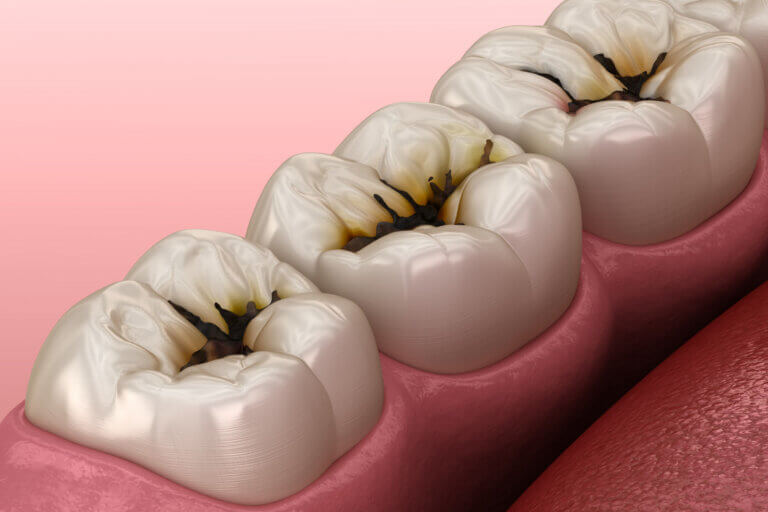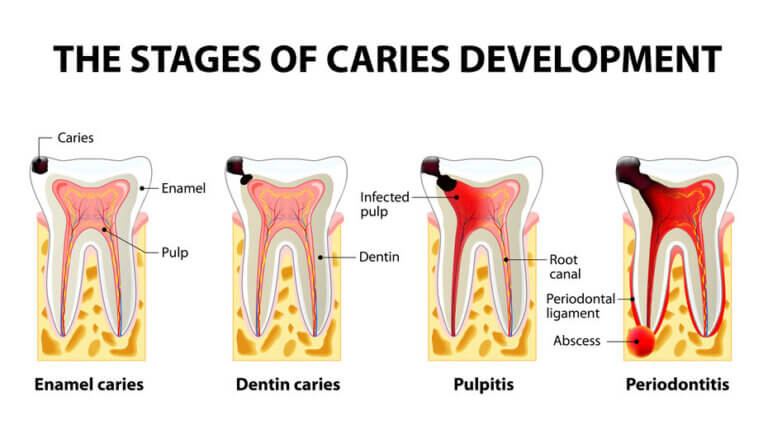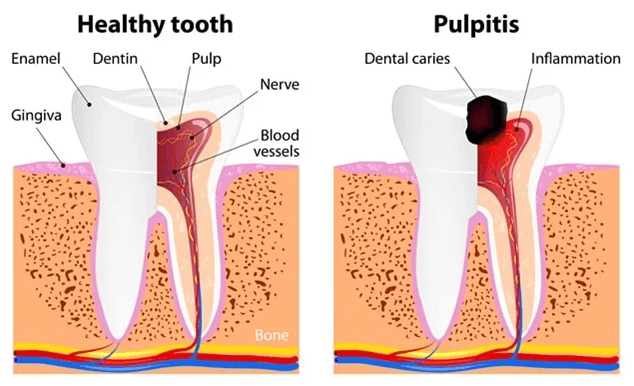Reversible Pulpitis

What Is Reversible Pulpitis?
If you’ve ever experienced a sharp, fleeting toothache when indulging in your favorite ice cream or a hot cup of coffee, you might have encountered a dental condition known as “Reversible Pulpitis.” While it might sound complex, this common ailment can be understood and managed by anyone, so let’s break it down.
Reversible Pulpitis is a dental issue that affects the innermost part of your tooth, the pulp. This delicate tissue houses nerves and blood vessels, serving as the core of your tooth’s vitality. When Reversible Pulpitis strikes, it means that there is inflammation within this pulp, leading to discomfort and sensitivity. But the good news is that, as the name suggests, it’s often reversible and can be effectively treated by dental professionals. Reversible pulpitis is typically caused by factors such as dental cavities, temperature extremes, minor tooth trauma, acidic foods and drinks, or dental procedures. However, if left untreated, reversible pulpitis can progress to irreversible pulpitis, a more severe and often irreversible condition, which may require root canal treatment or tooth extraction.
Before you contact a Toronto dentist to examine Reversible Pulpitis, there are some things you should know as a patient:
- Why Do I Have Reversible Pulpitis?
- Signs And Symptoms Of Reversible Pulpitis
- Treatment Options For Reversible Pulpitis
- Managing Reversible Pulpitis Until You Can See The Dentist
If you have questions about Reversible Pulpitis or other dental problems, please contact us for more information.
Why Do I Have Reversible Pulpitis?
Reversible pulpitis typically occurs when the dental pulp is mildly irritated or inflamed, but it is still capable of healing. Several factors can lead to reversible pulpitis:
- Cavities: Untreated cavities can expose the pulp of your tooth to harmful bacteria. These bacteria can cause irritation and inflammation, leading to pulpitis.
- Dental Trauma: Accidents or injuries that damage the tooth, like cracks or fractures, can expose the pulp, making it vulnerable to infection and inflammation.
- Tooth Grinding: If you grind your teeth, you can wear down the enamel, exposing the pulp. This friction and pressure can result in inflammation of the pulp.
Understanding the underlying causes of Reversible Pulpitis is the first step in preventing or addressing this condition effectively. If you suspect you have any form of pulpitis or are experiencing dental pain, it’s important to consult with a dentist for an accurate diagnosis and appropriate treatment. For more information about Reversible Pulpitis, please contact us.

Signs And Symptoms Of Reversible Pulpitis
Recognizing the signs and symptoms of reversible pulpitis is crucial for timely intervention and relief from dental pain. Here’s what to look out for:
- Tooth Sensitivity: One of the earliest signs of Reversible Pulpitis is increased sensitivity to hot or cold temperatures. You may experience a sharp, fleeting pain when consuming such items.
- Intermittent Pain: The discomfort associated with Reversible Pulpitis often comes and goes. It may be triggered by certain foods, beverages, or even air contact.
- Localized Pain: Pain is typically centered on a specific tooth, making it easier to pinpoint the affected area.
- Pain Relief: Unlike irreversible pulpitis, where pain persists, with Reversible Pulpitis, the pain tends to subside after the stimulus is removed.
- Pain on Chewing: You might experience discomfort when biting or chewing, especially when you apply pressure to the affected tooth.
- No Swelling or Abscess: Unlike more severe dental conditions, Reversible Pulpitis doesn’t typically lead to visible swelling or the formation of abscesses around the affected tooth.
- Discomfort Duration: The pain from Reversible Pulpitis usually lasts for a short duration, often for just a few seconds to a minute, and then subsides.
Recognizing these signs and symptoms can help you differentiate Reversible Pulpitis from other dental issues, and it’s essential to consult your dentist promptly for an accurate diagnosis and appropriate treatment. For more information about Reversible Pulpitis, please contact us.
Treatment Options For Reversible Pulpitis
When it comes to Reversible Pulpitis, the good news is that there are effective treatment options available to address the condition and alleviate discomfort. The primary treatment options for reversible pulpitis are:
- Dental Filling: If the primary cause of your Reversible Pulpitis is a small cavity, your dentist may recommend a dental filling. This involves removing the decayed area and filling the space with a tooth-colored material, such as composite resin.
- Desensitizing Toothpaste: Dentists often recommend desensitizing toothpaste containing compounds like potassium nitrate to alleviate tooth sensitivity.
- Custom Fluoride Tray Treatment: In cases of mild Reversible Pulpitis, your dentist may apply fluoride to the affected tooth to strengthen enamel and reduce sensitivity.
- Night Guard: If teeth grinding is contributing to your condition, your dentist may suggest wearing a night guard to prevent further enamel damage.
- Pulp Capping: In cases where the pulp is minimally affected, your dentist may perform a pulp capping procedure to seal the exposed pulp and promote healing.
Remember that the specific treatment for Reversible Pulpitis will depend on the severity and underlying cause of your condition, so it’s essential to consult with a dental professional for a personalized approach. For more information about Reversible Pulpitis, please contact us.

Managing Reversible Pulpitis Until You Can See The Dentist
Experiencing the pain of irreversible pulpitis can be distressing, but there are steps you can take to manage the discomfort until you can receive professional dental care. Here are some strategies to help alleviate the pain:
- Use Over-the-Counter Pain Medication: Over-the-counter pain medication can help relieve tooth pain or tooth sensitivity from reversible pulpitis. You are also welcome to use over the counter pain relievers such as ibuprofen (Advil) or acetaminophen (Tylenol). Ask your dentist what dosage is right for you, but if you do not have a pre-existing medical condition of allergies, 1000mg acetaminophen (Tylenol) with 600mg ibuprofen (Advil) every 4-6 hours or as needed is a very powerful combination.
- Cold Compress: Applying a cold compress to the outside of your cheek can help reduce inflammation and numb the affected area, providing some relief.
- Avoid Trigger Foods: Steer clear of extremely hot, cold, or sweet items that may exacerbate your tooth sensitivity.
- Rinse With Saltwater: Rinsing your mouth with warm saltwater can help reduce inflammation and kill bacteria. Mix a teaspoon of salt in a cup of warm water and swish the solution around your mouth for about 30 seconds before spitting it out. Alternatively, you can buy and use any mouthwash available at your pharmacy or health foods store
- Desensitizing Toothpaste: Apply desensitizing toothpaste directly to the affected tooth to help reduce sensitivity.
- Practice Good Oral Hygiene: Keeping the area around your affected tooth clean as possible can help prevent further damage and alleviate some of the tooth pain. Brush and floss gently around the tooth. Use a soft-bristled toothbrush to minimize further irritation of the affected tooth.
It’s important to remember that these measures are not permanent solutions but can provide relief until you can consult a dental professional. Reversible Pulpitis should be addressed by a dentist to ensure proper diagnosis and treatment. For more information about Reversible Pulpitis, please contact us.

